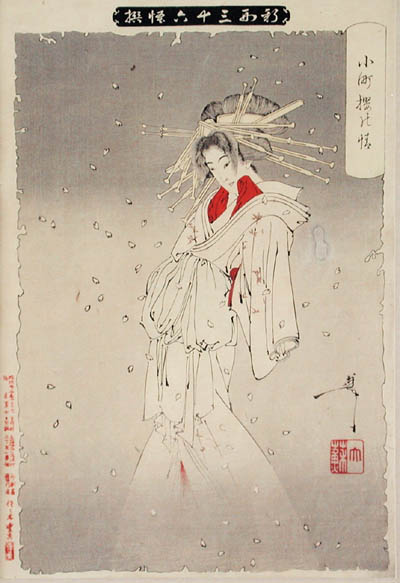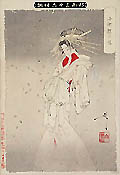| Title: |
The Spirit of the Komachi Cherry Tree |
| Artist: |
Yoshitoshi, Tsukioka (Japan, 1839 - 1892) |
| Date: |
October 1889 |
| Medium: |
Original Japanese Woodcut |
| Publisher: |
Sasaki Toyokichi |
| Printer: |
Matsuki Heikichi |
| Source: |
New Forms of Thirty-Six Ghosts |
| Note: |
Yoshitoshi:The undisputed master of Meiji
period art dating between (1868 & 1912), Yoshitoshi's woodcuts are now ranked beside those of Hiroshige,
Hokusai and his former master, Kuniyoshi. Yoshitoshi became a star pupil
of Kuniyoshi at the young age of eleven and, in 1853, designed his first
published woodcut print at age fourteen. Until 1860, Yoshitoshi's art
was influenced by the dominant Utagawa style, but after that date he broke
out into a striking form of artistic expression that was all his own.
Daring colour combinations combined with dramatic and expressive postures
began to lead the way, quickly influencing an entire era of Japanese art.
This is all the more remarkable when one considers that through most of
his life Yoshitoshi was continually afflicted with serious eye disorders
and mental breakdowns. At the time of his death, Yoshitoshi's fame was
so widespread that he had over eighty recorded pupils. |
| |
Deservedly, Yoshitoshi is now one of the most sought after of Japanese woodcut artists. "The Spirit of the Komachi Cherry Tree" is ranked among his finest late works of art. |
| |
"The Spirit of the Komachi Cherry Tree" originates from his last great set of woodcuts entitled, New Forms of Thirty-Six Ghosts. Within this series of thirty-six prints one finds the beauty, the horror and the wonder that distinguishes Yoshitoshi's genius. Work on the "New Forms of Thirty-Six Ghosts" was spread over a three year period, from 1889 to Yoshitoshi's death. Each woodcut was put on sale as soon as it was printed and published by Toyokichi. The set was extremely popular and a second edition was issued in 1902 by Matsuki Heikichi, a former student of Yoshitoshi and described to be the greatest printer-publisher of the late Meiji era. Distinguishing impressions from the two editions is very easy. The first edition woodcuts display vibrant colours where later impressions relied upon a more subdued, almost pastel palette. Such is here the case with this beautiful original impression. Furthermore, John Stevenson, in his book, Yoshitoshi's Thirty-Six Ghosts, writes, "The cartouche at the top right frames the title of the design. The colors in this cartouche are a clue to the impression. Three well-delineated colors show the print to be among the first off the blocks. On subsequent pullings, the colors in the cartouche are lighter and number only two." * |
| |
"The Spirit of the Komachi Cherry Tree" is the eighth published
print from the series. It stands as Yoshitoshi's final testament
to the beauty of the Japanese courtesan. The importance of both this
woodcut and the series it originates from cannot be overestimated. An
entire book has been written on this subject and "The Spirit of the Komachi
Cherry Tree" is deservedly illustrated on the front cover. * |
| |
A note on the Yokai & the Oni from Japanese legends: Supernatural apparitions commonly known in Japan as Yokai, sometimes spelled (Youkai), have been around in Japanese legends for centuries. Stories of the exploits of those worshiped as gods, and the misdeeds of the threatening, dark forces behind the noxious and sinister nature of those thought to be demons have been passed down through legends and folklore, eventually making their way into popular culture. Other words that have a similar meaning as Yokai may include, 'ayakashi, 'mononoke', or mamono', and a common English translation for Yokai is 'monster', but in reality, its meaning encompasses a vast array of mythological phenomenon. According to various superstitions and legends, it is believed yokai have an innate connection to the moon, some youkai are recognized as beneficial, and said to have the power to bestow good fortune and health; while others are presumed evil, dangerous, or just untrustworthy, and capable of frightening, intimidating, or even murdering their victims. Although they are very different in nature and appearance, most Yokai have certain characteristics in common, such as their arrogant attitude towards humans, their mischievous, and impish disposition, mystic powers, and the ability to create pandemonium. Today, Yokai are most often described as unexplained, but powerful apparitions with bewitching, or grotesque features. One of the most common powers attributed to the Yokai is the ability to alter their appearance, transforming or metamorphosing into anything or anyone, a clever trick that could lead to disconcerting or frightful experiences for humans. In Japanese folklore beings that posses this power are known as shape shifters, and changelings (obake, and bakemono). Yoshitoshi's original woodcut, "The Spirit of the Komachi Cherry Tree" is a striking example of Japanese art portraying supernatural apparitions. |
| Raisonne: |
* John Stevenson, Yoshitoshi's Thirty-Six Ghosts, John Weatherhill Inc., New York, 1983, pp. 34-35. Catalogue # VIII, Heikichi's second edition. |
| Size: |
OBAN (Sizes in inches are approximate, height preceding width of plate-mark or image.) |
| |
Framed and Matted with 100% Archival Materials |
| |
View larger Framed Image |
| |
 |
| Condition: |
Printed on late 19th century Japanese mulberry (rice) paper
as printed in 1902 in Heikichi's second edition. Containing a restored
hole to the right of the Spirit, else a strong impression with brightly
defined lines and colours. One should take note that "The Spirit of the
Komachi Cherry Tree" is one of Yoshitoshi's most highly regarded woodcuts. |
| Price: |
Sold - The price is no longer available. |
| Important Information: |
The artist biographies, research and or information pertaining to all the original works of art posted on our pages has been written and designed by Greg & Connie Peters exclusively for our site, (www.artoftheprint.com). Please visit us regularly to view the latest artworks offered for sale. We will soon be posting an update of our most recent research and include the biographical and historical information pertaining to our next collection of original works of art created by artists throughout the centuries. We hope you found the information you were looking for and that it has been beneficial.
Our Gallery, (Art of the Print / www.artoftheprint.com) guarantees the authenticity of every work of art we sell 100%. Full documentation and certification is provided. We offer a wide selection of international fine art dating from the early Renaissance to the contemporary art period. |










![]()
![]() or
phone Greg & Connie (905) 957-6666
or
phone Greg & Connie (905) 957-6666